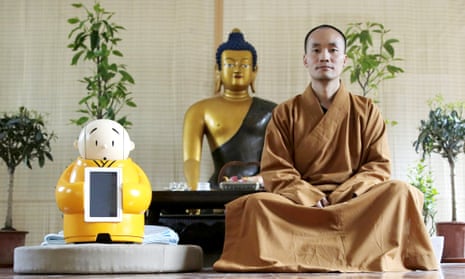In an unexpected synthesis of ancient and modern, a Buddhist temple on the edge of Beijing has developed a robot monk who can chant mantras and and explain basic tenets of faith.
At 2ft high, Xian’er is encased in saffron-yellow robes and has a shaved head. Despite spending much of his time closeted in the spiritual calm of Longquan Temple, he wears an expression of permanent surprise.
This article includes content hosted on reuters.com. We ask for your permission before anything is loaded, as the provider may be using cookies and other technologies. To view this content, click 'Allow and continue'.
His purpose is to reach out to people who are more connected to their smartphones than their inner being. Xian’er can answer 20 simple questions, displayed on the touch-screen on his chest, about Buddhism and daily life at the 500-year-old temple.
Master Xianfian, a (human) monk at Longquan and Xian’er’s creator, said artificial intelligence could be harnessed to spread Buddhist wisdom in China.
“Science and Buddhism are not opposing nor contradicting, and can be combined and mutually compatible,” he told Reuters.
Buddhism filled a gap in a fast-paced, hi-tech existence, he added. “Buddhism is something that attaches much importance to inner heart, and pays attention to the individual’s spiritual world … I think it can satisfy the needs of many people.”
Xian’er was developed as a robot in a joint project between the temple, artificial intelligence experts at Chinese universities and a technology company.
Since he was created, he has appeared at several robotic fairs across China, but spends most of his time in deep meditation on an office shelf in Longquan.
He started his existence as a cartoon drawn by Xianfian when he joined the temple in 2011. Xianfian described Xian’er as “a reflection of innovative Buddhist spirit … [who] might help traditional Buddhism reach a wider public more easily.”
Master Xuecheng, the head of Longquan and president of the Buddhist Association of China, is a digital communication enthusiast.
“Buddhists should not only seek enlightenment through daily learning, meditation and cultivation to gain positive energy from Buddhist doctrine. They should also contribute more to society, by transforming their own gains, kindness, compassion and wisdom to others through the internet and new media,” he told CCTV.









Comments (…)
Sign in or create your Guardian account to join the discussion